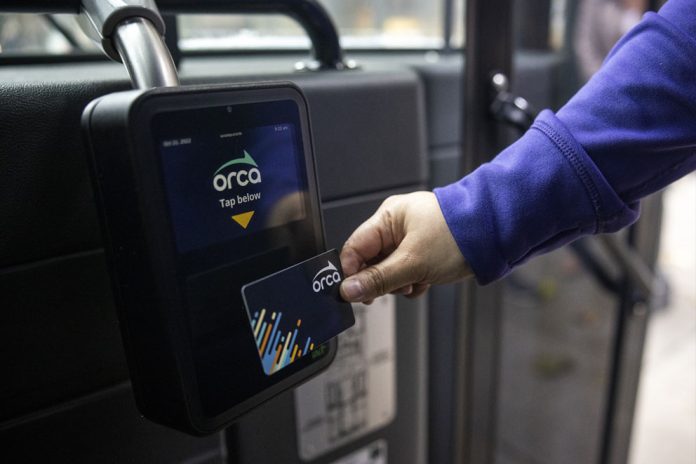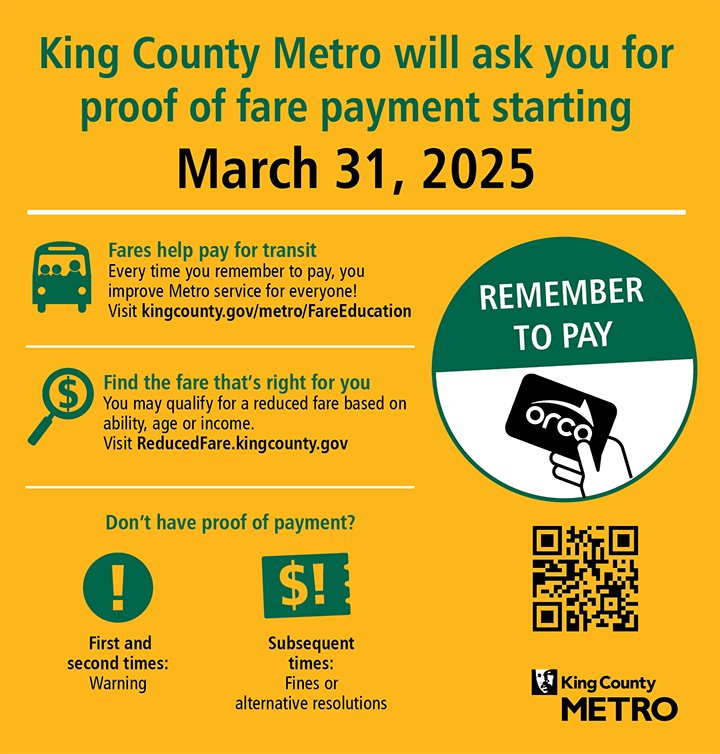
After a five-year hiatus, King County Metro is restoring fare enforcement. The agency will focus its efforts on RapidRide lines, high-ridership bus routes, and both Seattle Streetcar lines, starting on Monday, March 31. The new fare enforcement system will be a lighter touch approach with several warnings before advancing to fines and alternative resolution paths.
Metro implemented a new fare enforcement system in 2019, before formally suspending fare collection and enforcement at the onset of the pandemic as a social distancing measure. The agency resumed fare collection in the fall of 2020, but without enforcement.
In the interim, Metro has developed the Safety, Security and Fare Enforcement (SaFE) Reform Initiative, adding behavioral health support, station agents at transit centers, and changes to the agency’s Code of Conduct, in addition to evaluating further equitable changes to fare enforcement. Through that process, the fare enforcement system was reimagined by staff and stakeholders, leading to the new iteration set to launch Monday.
Initially, Metro will relaunch fare inspections with 30 fare enforcement officers on hand. These individuals will come from the agency’s security officer team, a group that consists of 175 personnel. In time, the number of fare enforcement officers could change, depending upon performance of the program.
When fare enforcement officers are dispatched to inspect fares, they will operate in groups of two or three and board at separate doors. Fare enforcement officers will then work their way through the bus toward the middle. During inspections, riders will need to present valid fare media.
Valid fare media includes a recently tapped ORCA card (plastic or digital), an active Transit GO Ticket on a mobile device, or a paper transfer slip, which can be obtained from an operator by paying cash at a farebox. A regular adult fare on Metro services is $2.75.
Some riders are eligible for reduced fare programs, such as via the ORCA Lift program for low-income riders or the discounted $1 fare program for seniors (ages 65 and up) and disabled riders. Youth aged 18 and younger can ride free, but should obtain an Youth ORCA Card if aged 13 or older.
For the first two months, fare enforcement officers will conduct an education campaign. As part of this, fare enforcement officers will ask riders to present valid proof of payment, and if a rider cannot produce such proof, fare enforcement officers will provide verbal reminders on the need to have proof of payment and let riders know about fare payment options.
“These first two months will not be focused on foreshadowing consequences, but our materials are making it clear that May 31 marks the start of written warnings and citations,” said Jeff Switzer, a Metro spokesperson.
Starting on Saturday, May 31, the grace period will be over and fare enforcement officers will issue written warnings that escalate into formal violations with repercussions for repeat offenders, similar to Sound Transit’s program. The first two violations will result in written warnings while third and following violations will result in either a fine or alternative resolution process.

If a rider is subject to a fine, the fine amount will be $20 if paid within 30 days and $40 if paid after 30 days but within 90 days. Riders, however, could choose to pursue an alternative resolution option instead of fines. Those options include:
- Loading $20 onto an ORCA card, or if eligible under a reduced fare program, loading $10 onto a reduced fare ORCA card;
- Enrolling into a reduced fare program, if eligible;
- Performing two hours of community service; or
- Appealing the violations to Metro’s Fare Adjudicator or requesting a customized resolution path.
“If the rider does not pay a fine or pursue an alternative resolution within 90 days, the Fare Adjudicator will contact the customer,” Switzer said. “We recognize and acknowledge that not everyone will be able to resolve their citations through the listed alternate resolutions, but the Fare Adjudicator will work with them to find a resolution.”
Switzer said that Metro sees mobility as a human right and has a goal of not removing riders just because they aren’t able to pay fares or fines.
“Riders may be asked to leave the co ach though if they do not cooperate with fare enforcement officers or are violating Metro’s Code of Conduct or acting in an unsafe way that affects themselves, the operator, or other riders,” Switzer said.
Metro calculates that fare evasion remains high even in the post-pandemic environment, with agency estimates putting the share of riders skipping out on fare payment around one-third. In 2019, the agency estimated its evasion rate was under 4%.
Fare collection is critical to Metro being able to maintain and expand service. In absence of fare revenue, the agency would be forced to cut service levels — barring other funding sources materializing. The agency is already anticipating a major fiscal cliff due to a convergence of flattening revenue streams and huge capital projects to implement its bus electrification plans.
The agency estimates that it took in $73 million in fare revenue during 2024 while fare revenues were more than double that in 2019. Even when fare revenue is high, sales tax revenue makes up the bulk of Metro’s annual budget, which is projected to exceed $718 million in a $1.15 billion operating budget for 2025.
King County’s long-standing policy for Metro had been a farebox recovery ratio of at least 25%, with a target of 30%, which the agency was largely successful at prior to the pandemic. But under recently adopted policy, Metro’s floor is set at a 10% farebox recovery ratio, with a target of 15%. In 2023, the agency’s farebox recovery ratio was slightly below 10%.
This fall, Metro plans to increase regular adult fares to $3.00, in line with the cost of Sound Transit’s light rail and bus fares. Seattle Streetcar fares, however, will remain at $2.25.
Looking further ahead, Metro is poised to roll out all-door boarding across its bus network, which entails riders paying for fares at mid- and rear-doors with onboard ORCA readers. Metro has installed all-door readers on 75% of buses and is still working to install them systemwide, which it aims to do by the end of 2025. Officially, riders are still supposed to board at the front unless riding a RapidRide line or a bus on Third Avenue in Downtown Seattle, but implementation of the fare enforcement regime over the coming months will check off another precursor to Metro officially rolling out all-door boarding across its bus network.
Stephen is a professional urban planner in Puget Sound with a passion for sustainable, livable, and diverse cities. He is especially interested in how policies, regulations, and programs can promote positive outcomes for communities. With stints in great cities like Bellingham and Cork, Stephen currently lives in Seattle. He primarily covers land use and transportation issues and has been with The Urbanist since 2014.


